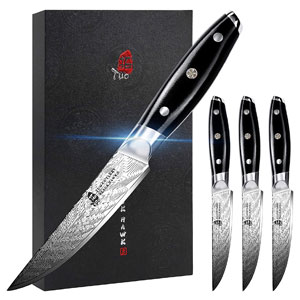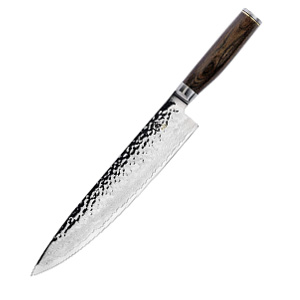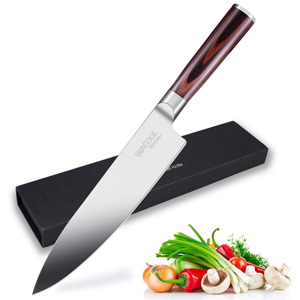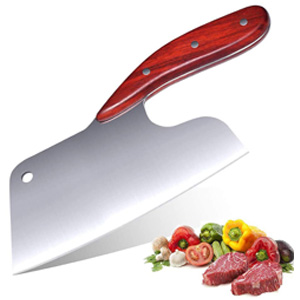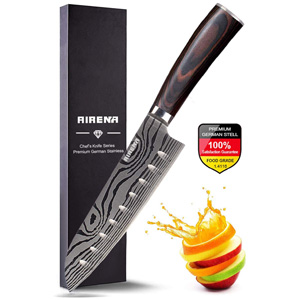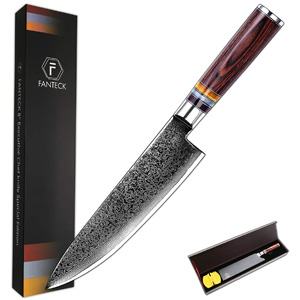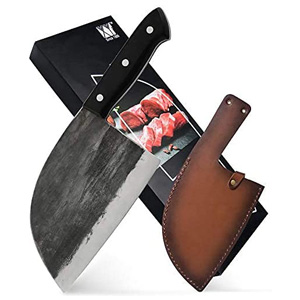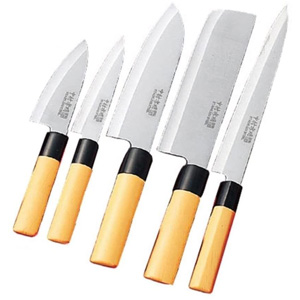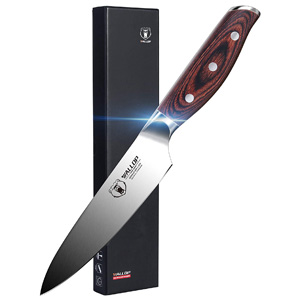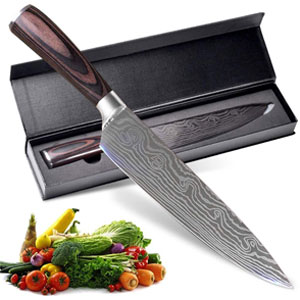10 Best Japanese Kitchen Knives for Home Chefs to Professional Chefs

Absolutely beautiful, delicate designs and cuts like a charm! If we were to tell you about the best Japanese kitchen knives, these are the exact words we will use to explain their functionality and aesthetics. To elevate the flavors and to enhance the beauty of the dish, there aren’t a lot of competitors for the thin, intricate, and sharp blades of these Japanese kitchen essentials.
Now there are different varieties to pick from Yanagi, Nakiri, Santoku, or Gyuto–whichever you pick, you need to make sure that you’re serious with it. Getting a petit blade may be good enough to make delicate Salmon Nigiris at , but not if you are planning to prepare wagyu steaks. Therefore, looking at factors such as style, durability, quality, and sometimes the brands becomes essential.
Thankfully, you’ll find all the hard work done here. You will get ten of our best recommendations with cutting strokes so divine that you will want to stay in the kitchen!
Out Top Picks of Best Japanese Kitchen Knives
- Best Value for Money: TUO Professional Kitchen Steak Knife Set of 4
“With the combination of esthetic appeal, hardness and sharpness, this is for those who aren’t scared of crazy chopping moves!” - Best High-End: Shun Cutlery Premier Chef’s Knife
“For everyone that loves fine dining and cooking for fine dining, this is a high-end knife of dreams. Stunning architecture.” - Best Handle: WACOOL Pro Kitchen Knife
“Thin blades, sharp cuts and a comfortable grip. You couldn’t ask for more.” - Best for Sharpness: Promithi Effort Saving Kitchen Knife
“Sharp blade and raised handle combination truly makes the cutting activities effortless.” - Best Durable: Airena Santoku Japanese Chef Knife
“A knife that lasts long, cuts well and holds on to the fame and utility of Japanese chef’s knives.” - Best Design: FANTECK Kitchen Knife VG10
“To make your way through tough cuts of beef or dainty vegetables, this is the deal with the best functional design.” - Best Overall: XYJ Forging Serbian Chef Knife
“An all-around combination of durability, strength, comfort, sharpness and multipurpose knife.” - Best Budget: Enjoy K Shop Japanese Kitchen Knife
“To practice your knife cutting and chopping styles. The starter set of Japanese knives for beginners.” - Best Small Kitchen Knife: WALLOP Paring Knife
“A kitchen knife that can do all kinds of small to medium work and can help you entertain guests with your skills.” - Best for Use: AUIIKIY Professional Chef Knife
“-use option for those who want to try some different cutting styles at with a light and dainty precision knife.”
Best Japanese Kitchen Knives in Video Review
Product Reviews On The Best Japanese Kitchen Knives
Before we show you a guide on how to get yourself the best Japanese kitchen knives for your kitchen, take a look at 10 of these that make the top cut.
1. TUO Professional Kitchen Steak Knife Set of 4
- Texture: By using the forging technique, a 3D pattern is given on the blade. This gives it a delicate appearance, by which you can work your way through the food to create complicated designs.
- Quality Steel: The special-forged German stainless steel used in the blade has gone through both cryogenic tempering and heat treatments. So you get a corrosion-resistant blade!
- Comfort: When you touch the grip of the handle, it is important to feel the fit in your palm as perfect. If it is too big or small, you will feel clumsy and won’t be able to work. But this one has the perfect fit that also reduces the burden on the wrist.
If you wanted to have the benefit of a full-tang knife, a professional chef knife, and a value set (in case you break one of your knives for mismanagement), this would be an excellent choice. This knife comes with a beautiful design and a brushed finish.
And like any top-quality knife, the handle has a comfortable grip. When it comes to the edges, you will find them to be as polished as they are sharp.
However, this model is good enough for professional chefs only when they are wearing gloves; otherwise, it can cause injuries.
- Stunning visuality of the knife adds aesthetic appeal to the kitchen.
- Harmonized design that is easy to hold and work with.
- Manual polish results in high-degree hardness and sharpness.
- Excellent cutting ability from the straight edge.
- Can be used to slice steaks and make vegetables.
- Not so good for butchering purposes as home cooking purposes.
- Not for those with soft skin, as the sharpness can cause chaffing.
2. Shun Cutlery Premier Chef’s Knife
- Maneuverability: The blade is light and hence agile; this is why even though the knife is large, it is easy to control. If you like large knives like a professional chef or trained home cook, you will be able to handle this with ease.
- Efficiency: More blade length means more volume of the product for you. Does this mean good for you? Yes, when you are cutting large sections of food, and you need to cover more areas in a short time!
- Cut: Thanks to the hammered Tsuchime finish, the food does not stick to the knife after each slice. So, you can focus on the cutting instead of taking time to scrape off the sliced pieces off the blade.
So you want to discuss chef’s knives, and you think we will forget Shun?
No way! They make kitchen knives that speak heart to heart with Japanese cuisine, bring out the flavor and freshness of seasonal foods and let you prepare food with perfection! Anything ornate you imagine to do with these, you can.
But what makes these knives so special? Each Shun knife is handcrafted with 100 precise, fine, and individual steps. But don’t think sticking to the heritage means they don’t have modern counterparts!
They are made of premium materials and modern technology that provide a combination of tradition and quality.
- Has a contoured handle that is easy to hold and feels comfortable in hand.
- Handles all kinds of food, large or small.
- Easily transfer food from knife to cutting board to the pan without sticking.
- Hand-sharpened and handcrafted.
- Great for professional chefs cooking in the fine dining industry.
- Not for untrained home cooks.
- Does not cut on a butcher block.
3. WACOOL Pro Kitchen Knife
- Ergonomic: Why is the handle so good? Because the blade is integrated with the handle. You can also get the right balance between the thin blade and the handle, ensuring ease of movement with this knife.
- Anti-Corrosive: With a combination of high-quality stainless steel with 0.5% carbon, 15% Chrome, Molybdenum, and Vanadium, the blade is harder than regular ones, more corrosion, and abrasion-resistant. This is why you will find them to be tougher than other knives!
- Sharp: The 2 mm thick blade makes any cutting easy and swift, thanks to its sharpness. So you can do any kind of chopping, mincing, and dicing, and slicing of fruits, vegetables, and several meat varieties. But it is 8 inches long, as opposed to the 10-inch long Shun Cutlery Premier Chef’s Knife.
What’s in a knife if you can’t hold it comfortably? You could be making sushi or steak, but the handle is just as important as the blade. Having a knife that fidgets in your hand or causes you to switch its position mid-slicing and mid-dicing is not a good feeling.
So, we want you to have a knife that is comfortable to hold, easy to cut with, and looks beautiful in the kitchen too. Guess where we stopped?
At Wacool! Now listen, we aren’t saying they are the best handle by design (although they have good and minimalist designs), but they are the best for the grip.
- All-around cooking knife with tough construction.
- Balanced weight allows confident chopping.
- Right shape and size to feel comfortable in hand.
- Slices and chops food quickly and clean due to its sharpness.
- Thin and sharp blade with great cutting delivery.
- Wooden handle does not fare well with the dishwasher.
- The box helps with only covering the tip of the knife and not the entire blade.
4. Promithi Effort Saving Kitchen Knife
- Handmade: The handle of the knife is made of wood. Hence, it is not only of good shape but also of a great material that lasts long and is durable.
- Full Tang: Besides the single forged design that has been used to make the knife, another thing is important here. The manufacturers tested it for ground process, making the blade super sharp and hence super easy to cut with! However, the grip isn’t as good as WACOOL Pro Kitchen knives.
- Multifunctional: You can not only chope and dice vegetables but also do fish fillets and slice through tender cuts of meat with this multifunctional model of a knife.
Often when using the knife to chop, you may have felt this problem. It is not being able to push your way through the entire potato or tomato without hitting the table already with your fist.
You would have wanted to go down, but because the handle is in line with the blade, the blade enters the food diagonally, with the front cutting deeper than the posterior of the vegetable. And you know the reason behind this?
Your handle and your hand didn’t let the posterior part of the blade meet and cut through the back end of the food. To solve this problem, we have the raised handle and sharp goodness of this knife!
- Transfers power better than regular meat cleavers.
- Very sharp blade with a nice polish.
- Made for both light and heavy-duty tasks.
- No sore hands after heavy cutting and chopping for long hours.
- Edge holds up quite well after continued use.
- The wood lacked sanding in some handles.
- Not as secure as the others when it comes to the grip.
5. Airena Santoku Japanese Chef Knife
- Santoku: As you know, chopping and cutting different styles of meat and vegetables is common for chefs. But sometimes, the western knives can’t deliver good cuts in both meat and vegetables with the same knife. This one is built a little heavier than Japanese knives with a relatively circular tip so that you can do any sort of cutting!
- Design: Since you have a moderate thickness in the blade, it is not light and airy and not too heavy. The balanced weight makes it easy to use and hard to break from mishandling.
- Cutting: With the edge retention of the blade, you get a cutting performance that is tough and at the same time strong and low-maintenance.
What is more effort-saving than not having to invest in a knife anytime soon, right? That’s what we thought too. Like the Promithi Effort Saving Kitchen Knife, this one from Airena also holds popularity for its sharpness. But is the comfort the same?
Although the handle here is not raised like the Promithi model, it sure is designed ergonomically to give you a good grip. And it wins the lottery with the pakkawood frame of the handle that ensures not just greater longevity, but the power-packed combination of superior control and comfort.
- Ties the bridge between chef’s knives and regular kitchen knives.
- Works as an excellent chopper and mincer with a traditional Santoku design.
- Hits the balance between sharpness and toughness without being brittle.
- Pinch grip technology of the blade spine makes it easy to hold.
- Sharp cuts allow an easy clean-up after each use.
- Might need more sharpening for highly professional users.
6. FANTECK Kitchen Knife VG10
- Versatile: Whether you are a man or a woman who uses your left or right hand, you will find it very easy to use the knife. Not only that, it can be used for mincing meat, chopping vegetables, slicing fruit, and much more whether you are in your restaurant or at home!
- Resistant: The 67 Layers VG-10 Japanese high carbon stainless steel construction allows the best steel characterization of the knife. So, now you can enjoy stain-resistant cooking and storing! Besides resisting tough stains, it also performs with strength for durability for the same construction materials.
- Comfortable: With the combination of pakkawood handle and acrylic rims, this knife allows both rocking motion and front-to-back motion, letting you cut any way you want with ease.
For those people who need a functional but most importantly, a good-looking kitchen appliance, we found the right design of Japanese knives that would go well with the rest of your cutlery.
You have seen nothing of convoluted and maizlike blade design if you haven’t seen one of the Fanteck Japanese knives! With handles very similar to Airena and Wacool Japanese knives, these are different in the material of the blade. Fanteck used super sharp real Damascus Steel here instead of more common high carbon steel.
Another great thing? These are Gyuto knives. So they can work through tough cuts of beef (not the bone) with great ease.
- Hand-sharpened for a great cutting experience.
- Perfect balance of blade allows easy cutting.
- Excellent grip from the handle of the knife allows better control when cutting.
- Allows you to cut faster without physical fatigue.
- Clean, shiny, and sharp blades from the start.
- Handle-heavy blades may be uncomfortable for some users.
7. XYJ Forging Serbian Chef Knife
- High Quality Cleaver: Whether you are using it daily or once a week, the sharpness of the kitchen knife will hold strong with great robustness. The reason? Superior construction features high-manganese steel. And what’s more, its blade is a double-bevel and has gone through fine processing to back you up in the dicing, slicing, and chopping.
- Full Tang: To save you from the woe of broken handles, the entire handle and blade line is integrated with single steel without any soldering like the Promithi Effort Saving Kitchen Knife. This, along with the non-slip effect of the handle, makes the knife long-lasting, easy to hold, and solid.
- Convenient: The unique leather knife sheath is not only a fancy cover for the knife but also a considerate storage unit. This lets you use the knife well and secure it for a long time. After all, maintenance is the basis of buying Japanese knives!
A butcher chef’s knife of your dreams! These would be the exact words we would use to describe this knife to friends, family, and Facebook you-may-knows. Just imagine this, natural knife grinders who know the business and the technique by heart, with their 30 years of experience and expertise, craft a knife.
How awesome would it perform in kitchens! This handmade knife can blow the mechanical ones out of the competition with its durability, high-quality forging technology, and the continuous hammering-tempering-clamping method of build that promises strength and high performance.
- The Pakkawood handle ensures a comfortable and stylish grip.
- Has a longer service life than regular kitchen knives.
- No feeling of tiredness despite long hours of cutting and chopping.
- Affordable butcher knife that can be used for plenty of mass chopping while retaining the sharpness.
- Hand forging would have ensured a better lineup of the blade.
8. Enjoy K Shop Japanese Kitchen Knife
- Western compound: This Japanese knife comes with a western compound in its traditional roots. This is why you will find it extremely easy to work with, unlike those light, airy, and ultra-sharp Japanese knives that need a boost of confidence before you work professionally with them.
- Multipurpose: Although the knives are not chef quality, each of them knows their work and serves the purpose. So whether you need to carve or cut, you can do it as and when required! However, it would be wise not to put so much pressure on them as beginner-friendly knives are prone to breaking if misused.
- Handle: The handle itself is light. So you don’t have to worry about getting tired from using these knives. But the thing is that it may be too light for heavy users to do any real kitchen business with.
Now, for the ones that want a great knife but without breaking the bank for it, what will you get? Should you go for petite knives that are good for carving, butcher knives that are good for meat cutting, or chopping knives like the Santoku?
Not to worry, as here’s a knife set that has five different kinds of Japanese knives, each with its own functionality and utility to serve your kitchen, cutting, and carving needs!
But here’s a deal: these are beginner-friendly knives. So if you are a professional chef looking to buy Japanese knife sets; this one is not for you.
- Excellent quality and value as a beginner’s choice.
- Great for practicing initial working with Japanese knives.
- Good option as a cheese and bread knife.
- Have a good look and feel.
- Lightweight, so might be prone to breaking.
9. WALLOP Paring Knife
- Premium Construction: This is made from high-quality German steel that gives you both durability and strength in the knife. It works to remove and prevent any sort of rust and corrosion while cutting. You can also see that the color is maintained even after prolonged use.
- Sharp: hand-sharpened knives are a blessing, and this small knife has it too. And since this is a double-bevel blade, it ensures your razor-sharp cutting edge is enough to complete your tasks!
- Elegant: The handle is triple-riveted and forged. For you, this means efficient cutting and balanced handling. And with the functionality, you can add the elegant wooden handle that accentuates your kitchen too!
When you think about knives, you think about 8-10 inch ones. Who would think a small knife could be useful or even liked by professional chefs?
We did! If you are someone for whom the size of the knife doesn’t matter (but the sharpness does), then you can try this sharp and small kitchen knife. And this paring knife can be used for more than carving and exquisite detailing.
You can use it to mince, dice, peel, and slice vegetables and fruits. So for your day-to-day kitchen tasks, or when friends come over to enjoy a treat at your home, this can be a good choice.
- Non-slip handle with ergonomic design for great balance.
- Sharp blades that keep away dulling and rusting.
- Full tang construction ensures finger safety and precise control.
- Minimizes the resistance from prolonged slicing for frequent users.
- Well-made for the price and quality of materials.
- Not very flexible.
- The fit and finish of the handle could be further improved.
10. AUIIKIY Professional Chef Knife
- Laser-tested: The stainless steel blade with which your knife is made has been laser-tested. This promotes the sturdiness of the blade and makes sure that you have a harder and sharper knife than usual.
- Ultra Sharp: hand-sharpened blades with a satin finish. Is there a better way to describe excellent blades? These are intricate blades with an efficient edge and a sharp performance that lasts even when you indulge in heavy knife work daily.
- Non-slip: As it doesn’t slide off your hands with a smooth handle, you can reduce cutting time with this knife. You do not have to adjust it! Also, there is no friction between the blade and the ingredients, helping you to maintain the texture and taste of the food.
Very similar to the Airena Santoku Japanese Chef Knife, this one has the same German high carbon stainless steel construction and wooden handle.
However, the Airena knife is seven inches, so it is one inch smaller than this one. But what is exceptional about it that we included it in the list?
One good thing is that both home chefs and professional chefs can use it for their home of professional work. And there is no hindrance as to in which tasks you can use it!
No matter big chopping or fine slicing, any kind of kitchen cutting work can be done with it. This is why Auiikiy makes a list as one of the best Japanese steel kitchen knives.
- Made of good quality materials.
- Easily chops medium to the hard texture of different food varieties.
- Retains the edge and can be sharpened easily.
- Strong handle that grips well.
- May cause blisters in hand if you are not careful as the blades are quite thin.
Types of Japanese Kitchen Knives
If you were fancied by Katanas up until now, you would be even more delighted to know that the best professional knife sets are equally blessed blades made in Japan. Although they specialize in different kinds of knives for different tasks, here are the four main types you will find.
Gyuto
Gyuto means cow sword. So these were meant originally for cutting, slicing, and prepping beef. You will recognize Gyuto knives for their extreme sharpness. This sharpness comes to great use when you need to do precision cutting for your dish, be it for meat or vegetable delicacies.
This is why you can use it for chopping, slicing, and mincing purposes as well.
Nakiri
Have you seen western meat cleavers? Nakiris are the Japanese version of the meat cleavers, except for one thing: you can use cleavers to pierce through bones, but you can not use Nakiris for the same. Instead of that, you use this knife to chop vegetables precisely, making ultra-thin cuts using the push-pull technique.
Petty
Bigger than a paring knife and smaller than Gyuto, this is what you call the Petty knife. It looks like a medium replica of the Gyuto and is used to make decorative art in the food, like carving and crafting shapes into it.
Santoku
When you talk about Japanese knives to Americans interested in such things, they visualize the Santoku. Santoku is the most common Japanese knife that has made its way into the American kitchen.
A great thing about Santoku? It is used for its three virtues of chopping, slicing, and dicing meat, fish, and vegetables.
Japanese Knives vs. German Knives
Imagine two different kinds of knives. One: heavy, bulky, and meant to do all the rough business in cooking; and two: light, delicate, and meant to amplify the natural taste of the food and play with its shape. And there you have it– the latter is Japanese, and the former is German knives for you!
When it comes to the steel with which they are made, Japanese knives have more carbon in them as opposed to German one. This is what makes them more brittle and hard.
Although they are hard, they are thinly made, which allows one bad thing and one good thing. The bad news is that tips and edges of Japanese knives break more easily and hence need more maintenance. And the good thing is that their thin nature allows them to be sharper.
Last but not least, German knives often have a full-tang build. This means that the same steel was used to make the top to bottom of the knife. This isn’t the case with Japanese knives. You will find them carrying more weight at the front and tapering inside handles, giving you more control.
Sharpening a Japanese Knife
There are a few things that you need to consider before sharpening your life: the ease of sharpening, the blades you have, the edge life of those blades, etc. Some chefs like to sharpen their knives before work, and others leave them sharpened after a day’s work. Whichever way you prefer, you could attempt the following steps to be done with it.
Things you will need: water, whetstone, cloth and of course, the knife. If you have waited for the knife to be truly dull before sharpening it, it’s going to take a lot of time. But if you wanted to sharpen it right out of the box, but after each day’s/alternate day’s of work, it’ll be a 10 minutes task.
- Wet the stone with water. If you have a fine stone, splash it with water as you go sharpening. If you have medium or coarse stones, soak them in water for 15 minutes before you start the process.
- Stabilize the stone by placing it on a folded cloth. This is going to save you from slips and cuts.
- Place your knife perpendicular to the stone. Use your index finger and thumb to hold the flat cutting edge and the remaining three fingers to hold the handle. Now, with the other hand, hold and press the edge of the blade on the stone.
- With increasing pressure, push the blade along with the stone, and with decreasing pressure, pull it towards you.
- Keep repeating till you see a burr along the edge. Now, flip and do it on the other side to even out the burr.
- Sharpen the Shinogi line by pressing down the middle of the blade, and you’re done!
Maintaining a Japanese Knife
Thanks to our extensive list and little research from your end, you laid your hands on the best quality Japanese kitchen knives. But don’t you want it to deliver the same results each time? To let the knives thrive in your cutting business, it is essential to maintain them well. And this is especially true for Japanese knives.
So how to do it?
- Always use hand washing methods and not your dishwasher to clean knives. The heat from the dishwasher can contract and expand the metal, causing trouble to its utility.
- When washing by hand, never use the silver scrubbing wires. Instead, use the green kitchen sponges as they are gentler.
- After each use of the knife, wipe it off with the soapy sponge first and dry it with a cloth. Don’t let it air dry. Since Japanese knives are mostly made of carbon steel, they can rust if air-dried.
- Your Japanese knife is not meant to go through bones. So beware of the brittleness!
- Always cut straight to avoid chipping of the blades and edges. Don’t cleave or twist, as these can dull the blade.
- Wood or plastic cutting boards will be your knife’s best friend. So if you have bamboo, slate, glass, or marble ones at home, no matter how fancy, stay away from using them with your Japanese knife.
- Store your knives safely. Either use a magnet or a knife block for a perfect display of the delicate handles. Storing in a knife bag made of leather or canvas is also a good option to not ruin it.
Things to Consider When Choosing the Best Japanese Knife Set
Now that you are sold on the cutlery and expertise of the Japanese kitchen knife set, it is time to let you know the secrets of landing yourself the best ones. Following this guide will make sure any knife you purchase is a great one!
Blade Types
Usually, western blades have a double-bevel style blade. But in the case of Japanese knives, you will find mostly single bevels. Single bevel knives are great for when you want to craft fruits and make sushis; you know the dainty things. But if you are a beginner, you should start with double-bevels.
Gyuto and Santoku offer double-bevel knives which you can use to cut fish, meat (not the bones), and vegetables. Go for Gyuto if you need longer blades and Santoku if your countertop space is small.
Steel Quality and Durability
You’ll find most knives made here of high-carbon steel/blue steel/white steel. That makes them super sharp, and at the same time, super hard and brittle. So only professionals have a good time working with them unless you can maintain it against chipping and breaking possibilities.
The moment stainless steel alloys are used for this purpose, your knives become more durable, repel rusting, and are easier to care for. But this comes at the cost of the sharpness that does not last very long. But it is good enough for home chefs.
Handle
The handles aren’t just meant to be beautiful, you know? So pay attention to these too. The style of your handle can be either Japanese or western style.
For force-cutting tasks that require energy and effort, and of course, safety, having a sturdy and heavy handle is important. The single tang between the blade and the rivet of the handle identifies this kind of knife.
On the other hand, Japanese knives have a handle that is cylindrical, light to touch but gives you more control when you get used to it. You will always find them made of wood.
Weight and Balance
If you have never used a Japanese knife before, touching it for the first time may feel weird for its weight above all things. But when you do precision cutting, this weight is what helps you keep the balance between making intricate details and cutting off the entire section.
Again, having a top-heavy knife with too much weight at the tip can also ruin your balance, so make sure there is a balance between the weight of the middle of the blade and the tip of it.
Frequently Asked Questions (FAQs)
Final Words
And that brings us to the end of our hunt for the best Japanese kitchen knives! If you don’t have a problem with splurging, you can definitely do it with the Shun Cutlery Premier Chef’s Knife.
But if you would like something that requires optimal investment, will last longer, and will cut beautifully for home chefs (professional chefs may need a little more sharpening), then go for the Airena Santoku Japanese Chef Knife. But what seals the deal for us is the XYJ Forging Serbian Chef Knife for its highly sharp index, durability, and environmental protection.
So did you find a favorite? If not, our guide is ready to help you in the hunt. After all, who doesn’t want a fine-cutting experience!

